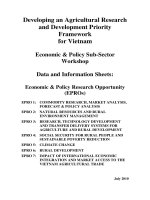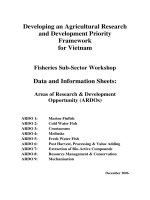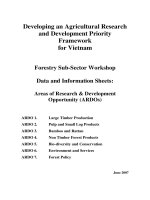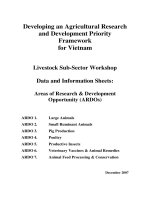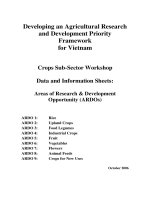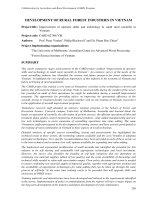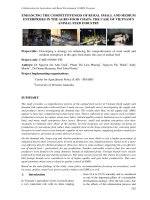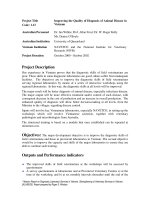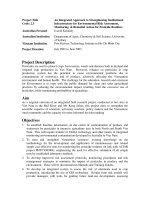Báo cáo nghiên cứu nông nghiệp " Developing an Agricultural Research and Development Priority Framework for Vietnam " pot
Bạn đang xem bản rút gọn của tài liệu. Xem và tải ngay bản đầy đủ của tài liệu tại đây (342.87 KB, 87 trang )
Developing an Agricultural Research
and Development Priority
Framework
for Vietnam
Workshop
Fisheries Sub-Sector
WORKBOOK
December 2006
2
WORKSHOP TIMETABLE
Date and Time
Registration
Workshop opening, briefing, introductions
Strategic context and methodology for setting R
& D Priorities in Vietnam
Data and Evaluation Sheets – Summary of Data
Sheets and Use of Evaluation Sheets
General Discussion
Working Group Formation and Discussions
Assessing potential benefits
Assessing adoption likelihood
Assessing scientific potential
Assessing research capacity
Results and interpretation of priorities
Priorities within ARDOs
Wrap-up session
Close
Fisheries Research and Development Priorities for Vietnam
3
WORKSHOP OBJECTIVES
Assess the national priorities for fisheries research and development in
Vietnam
Develop a plan for developing priorities and implementation strategies
for each of the ARDOs following the national workshops
WORKING IN GROUPS
All participants will be seated in mixed pre-selected groups. The majority of work will
be in these groups. The composition of groups will be changed as needed throughout
the workshop.
There are some basic “rules” for working effectively in workshop groups:
recognise that each person’s opinion is valid
take responsibility
for contributing
for understanding
2:1 rule
criticise but after positive feedback
listen actively
use ‘and’ instead of ‘but’
express yourself concisely
keep to time
turn off mobile phones – use only during coffee and lunch breaks
For each workshop session:
make sure people are allotted the task of taking notes
watch the time
Discomfort zone: issues may arise during the workshop that either cannot be resolved
quickly or are not appropriate for the workshop. These issues should be recorded in the
“discomfort zone”.
Fisheries Research and Development Priorities for Vietnam
4
EXPECTATIONS OF WORKSHOP/PARTICIPANT
INTRODUCTION
[Purpose is to ensure participants know who is there, where they come from, what
skills are represented, and consolidate expectations of the workshop]
Group discussion
Each participant
Who am I – name, affiliation, responsibility, interest/experience
What I want to happen at this workshop
What I don’t want to happen at this workshop
[2 minutes per person]
Tables
Pool expectations
Decide on 3 cards per table for each of wants and don’t wants
Report back One person from each table to provide brief pen picture of the table
(2 min per table)
Facilitator collect, group, paste cards
[Reporting to be on CARDS to enable visualisation of the output of each session and
typing of each session’s work for distribution to participants]
Fisheries Research and Development Priorities for Vietnam
5
STRATEGIC CONTEXT FOR CROP R&D IN VIETNAM
[Purpose is to develop a common understanding of the main issues facing the crop
sub-sectors in Vietnam to provide the context for priority setting]
Table Discussion
What are the major issues external (national and international) to this sectors
that have important implications for their future
What are the major issues internal to this sectors that have important
implications for their future
Identify the issues and implications, recording issue and implication on different
coloured cards
Half tables consider external issues and half tables consider internal issues
NOTES
Fisheries Research and Development Priorities for Vietnam
6
RESEARCH & DEVELOPMENT PRIORITIES METHODOLOGY
OUTLINE OF THE PRIORITY SETTING METHODOLOGY1
INTRODUCTION
The primary objective behind Research & Development (R&D2) priority assessment is to
determine the broad research programmes that will provide Vietnam with the greatest
return on investment in R & D provided by government and other major stakeholders.
Priority setting is the central issue of research and extension management. It is a complex
task. It must be done in a systematic framework able to allow the results to support open
and robust decision-making about research and extension resource allocation and
management. The highest priority R & D is that which has the highest economic, social
and environmental value to the nation.
Choices must be made about the Areas of Research and Development Opportunity
(ARDO) to support, and which not to support. If there are no established priorities, then
the choices made will be unlikely to produce results of maximum benefit to Vietnam. At
worst, the results will be irrelevant and provide no return for the public investment
involved.
is
as
ph
Em asis
ng ph
ro Em
St
ng
ro
St
d
it e
m
Li
EC
TI
V
IT
SE
L
IN
C
RE
A
SE
D
is
as
ph
m
eE
Y
iv
ct
le
Se
ATTRACTIVENESS
Figure 1: Use of Priorities to Assist in Selection of Research Programs/Projects
t
or
pp
Su
FEASIBILITY
1
CSIRO Australia has applied the basic model described here at corporate and division levels and it has been used in
more than 60 other research organisations in Asia, Australia and New Zealand, USA and Europe. The conceptual
analytic framework is based on the one published by the Industrial Research Institute, New York in 1986, viz: R N
Foster, L H Linden, R L Whiteley and A M Kantrow, Improving the return on R&D-I, in 'Measuring and Improving the
Performance and Return on R&D', IRI, New York (originally published in Research Management, January 1985).
2
Development includes technology development and transfer using transfer mechanisms including extension
Fisheries Research and Development Priorities for Vietnam
7
In the past the research and development program is driven by MoFi staff using an
allocative process. In the future MoFi will fund research under an open and contestable
process without bias. The aim is to improve the efficiency and effectiveness of
investment into research and to develop a research environment that encourages a high
degree of innovation. Under this process MoFi will clarify the priorities for research
investment and define the broad outcomes expected that investment. The research
providers will submit research proposals and budgets that will contribute to achievement
of these outcomes. In a “perfect world” those projects that offer the best value for money
will be supported.
There is a range of methodologies available for R & D priority setting. Selection of the
most appropriate methodology for Vietnam is driven by:
1. The need to use a consultation process that involves a large number and diverse
range of stakeholders;
2. The need to develop ownership of priorities amongst MoFi and research institute
staff, farmers, exporters, processors and marketers.
3. The absence of detailed and reliable statistical data on production, profitability,
and markets;
4. The need to move from R & D focussed on production and subsistence/food
security to R & D emphasising profitability, quality, marketing and commercial
systems;
5. The need to use an objective process that evaluates the likely economic, social and
environmental benefits to Vietnam;
6. The capacity to undertake appropriate research.
An important principle is to implement the process and learn from experience, doing
what make sense rather than worrying about academic perfection.
THE METHODOLOGY
Specific principles about priority setting include:
Consider areas that are easily related to the benefits from research (the purpose
of the research) not research disciplines – often called Areas of Research and
Development Opportunity (ARDO)
These areas should be mutually exclusive and collectively exhaustive,
consistently based, forward looking and manageable in number
Linked to and consistent with the research financing the process
Criteria are independent
The criteria used should consider:
o The potential economic, environmental, social, institutional and
scientific benefits from successful R&D
o The context within which R&D products and services will be used
o The state of development of required research tools and techniques
and the health of appropriate disciplines
o The availability of research skills and infrastructure
Importantly, priorities are relative; the lower the priority of an area the
greater the selectivity in choosing projects within them, as illustrated in
Figure 1.
Fisheries Research and Development Priorities for Vietnam
8
The model recommended for use in Vietnam is a five-step process.
1. Define broad Areas of Research and Development Opportunities (ARDOs) at he subsector level
2. Prioritise ARDOs at the sub-sector level
3. From the results of the sub-sector prioritisation establish ARDOs at the sector level
(these may combine some of the sub-sector level ARDOs into a larger grouping.
4. Prioritise ARDOs at the Sector level
5. Prepare workshop reports and a National R&D Investment Portfolio and Policy
Statement
Members of the Monitoring and Evaluation Network have benefited from training in the
priority setting methodology and have facilitated a pilot work designed to develop
competence in the methodology and in workshop leadership and facilitation.
It may also be useful at the sub-sector level to identify the research strategies (inputs)
such as biotechnology, nutrition, pest and disease management etc that are likely to
provide the largest gains in high priority ARDOs.
ARDO Definitions
The final form of ARDOs will need to be decided and approved. A logical approach is to
develop ARDOs at the sub-sector (Crops, Livestock, Forestry, Fisheries etc) level first
and use the methodology to prioritise them. From the results of these workshops a sector
set of ARDOs could be prepared. This will involve debate and in some cases
compromise. At the Sub-sector and sector level it is desirable to have less than 15
ARDOs as larger numbers become unmanageable. Large high priority ARDOs within a
sub-sector may become a sector ARDO, but smaller and lower priority ARDOs may be
aggregated. For example sheep and goats may be aggregated into small ruminants or
maybe beef, dairy, sheep and goats into ruminants.
ARDO need to be defined in terms of goal, scope and coverage. The goal describes the
results expected from all the research in the ARDO - e.g. for fruit “Improved yield,
quality, safety and potential to access high value markets”. Scope defines the broad
research input areas (disciplines) and Coverage the species or scale of production.
As an example the “Pilot Workshop” developed some definitions – e.g.
Pigs
Ruminants
Industrial
crops
National Goal: Enhanced productivity and profitability of the pork
industry
Scope: research that enhances the breeding, husbandry, nutrition,
disease management, production systems, hygiene, waste management,
quality management, transport, marketing and system integration
Coverage: small to medium-scale piggeries
National Goal : Enhanced productivity and profitability of the
ruminant meat and milk industries
Scope: research that enhances the breeding, husbandry, nutrition,
disease management, hygiene, waste management, quality
management, transport, and marketing of meat and milk
Coverage: beef, dairy cattle, goats and sheep
National Goal : Enhanced productivity, production area planning and
profitability of industrial crop industries
Scope: research that enhances the yield, pest and disease management,
Fisheries Research and Development Priorities for Vietnam
9
quality, post harvest storage and handling, processing, marketing of
existing and new crops, sustainable use of natural resources
Coverage: rubber, pepper, coffee, sugar cane, tea, coconut, cashew and
oilseed crops
Aquaculture National Goal: : Enhanced restocking of natural resources,
productivity and profitability of aquaculture industries
Scope: research that enhances seed production, nutrition, husbandry,
disease and aquatic resources management and environmental
management
Coverage: land-base and marine species - crustaceans (shrimp, crab,
lobster), finfish (grouper, tilapia, carp, snapper, bass, milk fish, mullet),
molluscs (clam, oyster, shell, pearls), seaweed and plankton
ARDO Priorities
The model used to form R & D priorities is a relatively simple. It asks participants to
evaluate the overall merit of R & D investment in each ARDO, in terms of Attractiveness
to Vietnam and its Feasibility in Vietnam. A scoring scheme is used to compare and
rank the ARDOs. Scoring is an effective way to allow a group to take all factors critical
to the decision into account in a logical and open way. The relative scores for each
ARDO are developed in structured group discussions in terms of four independent
criteria. These are:
1. Market & Production Potential Benefits for Vietnam
2. Factors Working For & Against Achievement of Potentials
3. Potential Contribution of R & D to Development
4. R &D Capacity Within Vietnam
The relationship between these four criteria is shown in the assessment framework below.
The relative rankings and positions of the ARDOs are important. They indicate the best
“areas” for research and/or extension investment. When the priority-setting group
represents researchers, extension workers and academics, farmers, politicians agricultural
industry and other stakeholders, the methodology ensures that the best recommendations
possible at the time are made.
An example of the outcome of the priority setting process
Fisheries Research and Development Priorities for Vietnam
10
Figure 1. Plot of attractiveness versus feasibility for a hypothetical set of eight ARDOs
showing their priority rating on the basis of their return to Vietnam.
RETURN FROM R&D FOR EACH AREA OF RESEARCH OPPORTUNITY
100
90
8
1
80
70
3
60
5
Attractiveness 50
40
6
7
30
4
20
10
2
0
0
10
20
30
40
50
60
70
80
90
100
Feasibility
In Figure 1, two ARDOs (# 1 and # 8) score the highest for both attractiveness and feasibility.
They are located in the top right hand corner of the graph. They warrant strong research and
extension emphasis, and are the highest priority group of ARDOs. Those located more towards
the centre of the graph (# 3, # 5, # 6 and # 7) warrant selective research and extension emphasis
and can be classed as moderate priority. The two with low scores for both attractiveness and
feasibility (# 2 and # 4) justify only limited support and have a low priority.
ARDOs # 3 and # 5 have similar attractiveness scores, but ARDO # 5 scores higher on
feasibility. In this hypothetical example the lower feasibility score for ARDO # 3 occurs
because the skills available to carry out the research and or extension are considered to be
inadequate. When the necessary skills are acquired, the two ARDOs would otherwise be equal
claimants for research resources. Attractiveness is determined by factors other than research
and extension, such as markets, profits, employment, social and cultural benefits, so while
ARDOs # 5 and # 7 have similar feasibility scores, # 5 is more attractive, and could be allocated
more resources for research and extension.
Priority Products within ARDOs
The ARDO scope lists all of the commodities/products within each ARDO. At the subsector level workshops it may be useful to use a simple process to rank these based on
the views and perceptions of workshop participants. At the end of this process, high
priority crops within high priority ARDOs will be defined. This will provide guidance
on where to focus the research effort (i.e. the scope) should be but will not provide
guidance on what aspects of research (the nature) should be undertaken.
Research Strategies
Once high priority crops within high priority ARDOs have been determined it is useful to
assess what areas of R & D inputs should be emphasised. The question to ask is, what R
& D inputs (R & D disciplines) are likely to provide the greatest impact. Impact is
normally a function of the size of the response expected, the length of time it takes to
obtain that response and if the response is permanent. For example traditional plant
breeding normally produces relatively small responses, they usually take a long time to
achieve, but any gains made are permanent (or almost so). On the other hand fertiliser
Fisheries Research and Development Priorities for Vietnam
11
applications often provide large benefits, in a short space of time, but usually are nonpermanent (i.e. fertiliser applications often have to be applied each growing cycle).
The priority setting process can also be used to establish the key research strategies within
each ARDO. In the absence of detailed data on each of the high priority products within
high priority ARDOs, a matrix of broad research strategies is a useful approach. An
example is:
Area of Research Input or Includes
Strategy
1. Cultivar Evaluation
Recommendations for improved crops in Vietnamese environments and for
different markets. Includes breeding, selection and evaluation of crops yield
and quality in different ago-ecological environments and for
resistance/tolerance to pest and diseases.
2. Genetic Improvement
New and improved genotypes. Includes traditional breed improvement
(selection) and development of new genotypes, breeding for improved
resistance, tolerance to pest and diseases
3. Agronomic
Improvement
Improved plant husbandry techniques to increase yields and quality and
includes propagation, establishment, weeding, pruning, shade, cultivation, crop
loading
4. Crop Nutrition
Improved yield, quality and profitability through efficient and effective fertiliser
use and water management practices. Includes suitable soils, fertiliser
requirements, fertiliser types, organic fertilisers, irrigation and mulching
5. Pest & Disease
Management
Development of improved integrated pest management practices and biological
control of economically important weeds, pests and diseases. Includes
chemical, physical, biological, integrated pest management, pest surveillance
6. Harvest/Post Harvest
Management
Improved harvest and post-harvest techniques to maximise the quality and
value of crops. Includes harvesting, drying, handling, storage, transport, quality
management
7. Processing
Value
Adding value to primary product or produce through processing it to a more
viable product or improving on the characteristic or performance of the original
product.
Includes development of quality standards, sorting/grading,
processing, new product development, use of by-products
Adding
8. Market Facilitation
Improved understanding and translation of market requirements for commercial
and semi-commercial farmers. Includes market information and requirements,
market access and pathways, linkages with exporters/processors, procurement
systems
9. Economic Evaluation
Development and advice on options for profitable farm production, processing
and marketing. Includes gross margin analysis, profitability, financial impact,
benefit : cost analysis
10. Alternative Production
Systems
Development and testing of profitable new crop production systems. Includes
organic production systems and multi-tiered crop production systems such as
agro-forestry.
11. Technology Transfer
To improve on technology transfer delivery systems and adoption of improved
technology by farmers through consultation, collaboration and understanding of
farmer needs. Includes seminars, field days, mass media, and alternative
extension delivery systems.
The priority setting methodology could be used to prioritise the research inputs for each
of the high priority crops/products identified. Prioritisation will be on the basis of two
Fisheries Research and Development Priorities for Vietnam
12
criteria: - Potential Impact of R & D Inputs on Development and R & D Skills and
Knowledge within Vietnam.
The inter-relationship of these two criteria on the emphasis placed on R & D Inputs in
research programs is shown below.
Fisheries Research and Development Priorities for Vietnam
13
AREAS OF RESEARCH AND DEVELOPMENT OPPORTUNITY
(ARDO)
A Preparation workshop identified ARDOs for the Crops Sub-sector.
The following areas selected comply with the principles that research areas to be
compared are mutually exclusive, collectively exhaustive, consistently based, forward
looking, and manageable in number. It is important also that they are independent of
organisational structure, easily reflect the benefits from successful research and are not
discipline-based. The areas for comparison are essentially areas of research and
development opportunity (ARDO) from which benefits will arise. In summary the areas
are:
ARDO 1:
ARDO 2:
ARDO 3:
ARDO 4:
ARDO 5:
ARDO 6:
ARDO 7:
ARDO 8:
ARDO 9:
MARINE FINFISH
COLD WATER FISH
CRUSTACEANS
MOLLUSKS
FRESH WATER FISH
POST HARVEST PROCESSING & VALUE ADDING
EXTRACTION OF BIO-ACTIVE COMPOUNDS
RESOURCE MANAGEMENT & CONSERVATION
MECHANISATION
Fisheries Research and Development Priorities for Vietnam
14
PRIORITY ASSESSMENT CRITERIA
The purpose of Vietnam’s research and extension effort in agriculture, fisheries and
forestry is to maximise the return to Vietnam through income generation and
environmental and social benefits. It follows that priorities should be assessed in terms
of Potential Impact and Feasibility.
The framework developed by the M&EN design workshop is a modification of that
developed by CSIRO in Australia, as shown below.
PRIORITIES FRAMEWORK
Potential
benefits
Potential impact
Likelihood
of uptake
Max return to Vietnam
through income
generation, environmental
& social benefits
Scientific
potential
Feasibility
Research
capacity
The criteria are defined as follows:
Potential impact
Potential benefits
• maximum additional benefits for Vietnam (economic,
environmental, social) from successful research and development
Likelihood of uptake of results
• likelihood of the results of successful research and development
being utilized by Vietnam
Feasibility
Scientific potential
• scope for growth in knowledge in the relevant scientific fields and
improvements in research and development tools and techniques
Research capacity
• Vietnam’s ability to competitively assemble research and
extension teams to deliver research outputs to users
Fisheries Research and Development Priorities for Vietnam
15
PRE-WORKSHOP ASSESSMENT OF ARDOs
[Purpose is to undertake a preliminary assessment of the relative priority of ARDOs
against Potential Impact and Feasibility criteria to enhance the level of discussion
during the workshop]
1) Read Data Sheets for all ARDOs
Carefully read all the Data Sheets (attached as a separate document) to
obtain an overview of all nine ARDOs
Make brief notes in the margins of the things from your own views and
experience you think are important for the on-going R&D program for each
ARDO.
2) Prepare individual preliminary ARDO Scores
i) Refer to the SWOT analysis for each ARDO
Instructions for preliminary scoring
Participants should score each ARDO before coming to the workshop and make
note of their reasoning to support their arguments in discussion. Space is provided
in the workbook against each ARDO.
Step 1 - For each criteria in turn, read the evaluation sheet for each of
the ARDOs, starting with Potential Benefits (refer to page 17 of this
workbook)
Step 2 – Now, select the three highest ARDOs and then the three lowest.
Step 3 – Now, score the HIGHEST ARDOs from 8 to 9, the highest
receiving 10. Then score the LOWEST ARDOs from 1 to 3, the lowest
receiving a score of 1. Finally, score the MEDIUM ARDO’s from 4 to 7.
The aim of the evaluation is to examine the relative differences between
ARDOs, so a wide spread of scores is desirable. A low score does not
mean that an area is unimportant.
Step 4 – repeat the process for the next three criteria (See pages
Step 5 – Having recorded your scores and reasoning in the Workbook for
the four criteria, transfer your scores to the consolidated score sheet and
bring it with you to the workshop. All scores will be tabulated and made
available at the workshop.
ii)
The purpose behind this procedure is to achieve as much discrimination between the
ARDOs as possible. We are interested in exploring the relative differences between
ARDOs. It is important to remember that priorities are RELATIVE. A low score does
not mean that an area is unimportant per se. However, when resources are limited,
decisions need to be made about where to focus the effort to achieve the greatest impact
for Vietnam.
NOTES:
Fisheries Research and Development Priorities for Vietnam
16
ASSESSING POTENTIAL BENEFITS
[Purpose is to provide an assessment of the relative Potential Benefits from each of
the ARDOs]
Potential Benefits refect maximum additional benefits for Vietnam (economic,
environmental, social) from successful research and development
Potential benefits increaseThe larger the size
– The faster the growth
– The greater the reduction in costs
– The higher the research intensity
– The greater the positive environmental and social impact
– The greater the spillover benefits
Procedure:
Table groups
Discuss potential benefits arising from each ARDO using preliminary scoring to
initiate discussion
Record on cards the major points that arise during discussion of each ARDO –
especially new and corrected information – different people at the table take
responsibility for different ARDOs
Report and post issues
Each participant to re-score each ARDO
Scores collected
NOTES
Fisheries Research and Development Priorities for Vietnam
17
POTENTIAL BENEFITS - PRELIMINARY ASSESSMENT AND SCORING
Please complete your preliminary evaluation before coming to the Workshop
ARDO
Score
1-9
Arguments and Questions
Reasons supporting your score; issues arising from data
and evaluation sheets
1: MARINE FINFISH
2: COLD WATER
FISH
3: CRUSTACEANS
4: MOLLUSKS
5: FRESH WATER
FISH
6: POST HARVEST,
PROCESSING AND
VALUE ADDING
7: EXTRACTION OF
BIO-ACTIVE
COMPOUNDS
8: RESOURCE
MANAGEMENT AND
CONSERVATION
9: MECHANISATION
Fisheries Research and Development Priorities for Vietnam
18
ARDO 1:
1.
ARDO DEFINITION
1.1.
MARINE FINFISH
National Goal:
To increase the scale of sustainable production and quality of marine finfish, including
the development of reliable seed stock and fingerling supplies and high value fish.
The MOFI target for 2010 is 300,000 tons of marine finfish with a market value of
US$4 billion.
1.2.
Research Scope:
Research to improve selection of appropriate species for local conditions and improve
brood stock culture, larval and fingerling rearing. Research in the development and
application of natural feeds for larvae and nursery culture and the reduction of trash fish
feeding systems through the use of compound feeds for the grow out phase.
Development of sustainable production systems including prevention, management and
control of disease, and identification and mitigation of environmental impacts.
1.3.
Coverage:
Main species include: grouper, cobia, Red sea bream, and sea bass.
2.
ATTRACTIVENESS TO VIETNAM
2.1.
Potential Impact:
A relatively new industry in Vietnam with potential for rapid expansion.
Expected expansion of local markets and development of export markets will provide
large increases in income for those who can afford to invest in larger scale
production.
Private sector development of seed stock, fingerling and grow out production
systems will provide employment opportunities and diversification of income
generating opportunities.
Selection of marine finfish species could be an alternative for the shrimp farms that
have been affected by white spot disease.
Expansion of marine finfish aquaculture industry and other related industry could
create employment for local labour and supports the poverty alleviation program of
government.
Increase of marine finfish production is a part of national fisheries development
strategy to reach the aquaculture production of 2 million tones, export value of
fisheries products about 4 billion USD, and will create 4.7 million jobs in the
fisheries sector in 2010.
NOTES:
Fisheries Research and Development Priorities for Vietnam
19
ARDO 2:
1
ARDO DEFINITION
1.1.
COLDWATER FISH
National Goal:
To diversify freshwater species to increase the value of freshwater aquaculture and to
meet the demand of domestic and international markets
1.2.
Research Scope:
Research on hatchery technology, grow out in different farming systems. Development
of suitable feeds and feeding systems, disease management and control and assessment
of environment impacts on and of aquaculture and food safety.
1.3.
Coverage:
Samonoidae family includes Oncorhinchus mykiss, white fish
Acipensidae family including Acipenser baerri, A. ruthenus
2.
ATTRACTIVENESS TO VIETNAM
2.1.
Potential Impact:
Development of diversified markets (mainly high priced domestic in the short term)
for high value fish and fish products including caviar and processed fish.
Import substitution (on a small scale).
Improve aquaculture status in the mountain areas due to investment of private sector
and more industrial style production systems
Increase of the value of the freshwater aquaculture products as well as better use of
water resources
Contribute to restructure of agriculture sector and poverty alleviation especially in
the remote areas
Generation of income in remote (poor areas) and creation of employment
opportunities in larger scale production systems and in processing (fillets and
smoked fish)
The provinces having the potential will have an opportunity to restructure the
agriculture economy with higher economical benefits
Biodiversity risks (competition with the domestic species, possible new introduce
diseases associating with the fishes)
NOTES:
Fisheries Research and Development Priorities for Vietnam
20
ARDO 3:
1.
ARDO DEFINITION
1.1.
CRUSTACEANS
National Goal:
To expand and diversify rearing methods and to improve the competitiveness, product
quality, food sanitation and safety (HAACP) of crustacean production for species of
major economic importance.
The Government target for aquaculture in 2010 is 2 million tons of yield, over US$2.5
billion in exportable value, providing employment and income for about 2 million
people. The target is for crustaceans to contribute to 60% of the total value of aquatic
products.
1.2.
Research Scope:
Research to improve technical process for hatchery reproduction, higher yield and
propagation quality, and to build the technological process of rearing for marketable
size product. Development of quality standards and quality assurance for seeds,
suitable food, and management rearing conditions. Research on solutions for safe
rearing, improvement in product quality and management and control of aquatic
diseases. Market development research.
1.3.
Coverage:
Priority objects for coastal culture : Tiger shrimps, mud crabs
Priority objects for sea farmring: lobsters
Priority objects for freshwater culture: Giant river prawns
2.
ATTRACTIVENESS TO VIETNAM
2.1.
Potential Impact:
Development of export markets, particularly through expanded production, and
attention to quality, food safety and trademarks will improve export income and
income for producers
Large and increasing domestic markets as the per capita income of the population
increases.
Stable development of crustacean juvenile and market size production will create
employment opportunities and contribute to eliminating hunger and reducing poverty
in coastal areas, highland and remote villages
Diversification of products and enhancement of product value will improve foreign
currency income from exportation and aquacultures contributions to GDP
Improvement productive efficiency, qualitative and quantitative products will
enhance competitive ability and profits for fishermen.
Zoning ecological areas and suitable cultured areas to develop shrimp and crab
culture, to set up stable cultural models will result in increase in yields and
productive efficiency
Fisheries Research and Development Priorities for Vietnam
21
Intensification and increases in scale of production systems will assist in
improvement and management of quality and supply.
Development of a network for management seafood production quality such as
setting up organizations to certify source and safety of foodstuff, development of
certification/auditing systems at the district and village level and management and
control of inputs including feed, medicine, chemical, juvenile and output things as
marketable products is likely to assist competitiveness and meet the marketable
demands.
NOTES:
Fisheries Research and Development Priorities for Vietnam
22
ARDO 4:
1.
ARDO DEFINITION
1.1.
MOLLUSKS
National Goal:
To promote the development, research and culture of mollusk species for national food
security, and assurance of food safety for domestic and export markets.
1.2.
Research scope:
Research to improve the production, competitiveness, quality and food safety of
mollusk culture in Vietnam.
1.3.
Coverage:
Status of mollusk aqua-culture in general and several high economical value species
including: Oyster, Scallop, Clams, Abalone, Cockles, Squid, Conus, Octopus
2.
ATTRACTIVENESS TO VIETNAM
2.1.
Potential Impact:
Mollusk cultivation is considered important due to the high commercial value of
target species.
Domestic and export markets expected to expand significantly
Potential for expansion of area under mollusk cultivation likely to significantly
increase
Valuable production option for enhancement of the environment and improvement of
quality in the areas which have been polluted.
Relatively low technology, but labour intensive which will help to create more jobs
for people in rural areas.
Mollusk culture provides further diversification in aquaculture which will assist in
minimizing risks caused by large scale mono-culture practices.
Due to filter features of mollusk species, it is possible to apply alternative,
rotational/poly-culture cultivation of mollusk species with species like shrimp, crab,
fish to enhance aqua-cultural environment and to increase the efficiency of usage per
unit of cultivating area
Apart from being food for human, mollusk products have been used popularly for
other purposes in agriculture, industry, medical and fine art.
Contribution to hunger alleviation for fishers in poor communities where potential of
culture is high
NOTES:
Fisheries Research and Development Priorities for Vietnam
23
ARDO 5:
1.
ARDO DEFINITION
1.1.
FRESHWATER FISH
National Goal:
Increase intensification, profitability, food quality and safety and export income from
freshwater fish while minimizing environmental impacts from increased production.
Targets:
Tilapia: 300.000 tons of marketable size fish by the year 2015.
Catfish: Production of 1.0 million. tons by the year 2010.
1.2.
Research Scope:
Research into genetic improvement for higher growth rate in fresh and brackish water,
selection for adaptability to higher salinity environments, improvement of seed stock
quality and availability, improvement of culture technology, feeding systems, disease
control and management, mitigation of environmental impacts, food safety and
intensification of larger scale production systems.
1.3.
Coverage:
Tilapia: including O. niloticus, O. aureus, and Oreochromis spp.
Catfish: including Pangasianodon hypophthalmus, and Pangasius bocourti
2.
ATTRACTIVENESS TO VIETNAM
2.1.
Potential Impact:
Tilapia
Increasing domestic and international markets to provide income generation for
farmers. Currently the domestic price is higher than export prices.
Opportunities for expansion of export markets.
Diversifying product for increasing market demand in term of both domestic
consumption and exporting, creating more employment and related services
There may be some negative impacts on surrounding environments including
pollution, biodiversity, and disease.
Catfish
Increased income for smallholders from increased production and improved quality.
Expansion of already sizeable export markets to provide increased foreign exchange.
Development of the private sector through seed centers, and fish processing factories
Application of new technology will enhance production and processing of fresh
filleted fish in accordance with international hygiene and quality criteria.
Fisheries Research and Development Priorities for Vietnam
24
Environmental impacts may be important and may impact on expansion of catfish
production and potentially human health and on the potential development of
antibiotic resistance.
NOTES:
Fisheries Research and Development Priorities for Vietnam
25
ARDO 6:
POST-HARVEST, PROCESSING & VALUE ADDING
1.
ARDO DEFINITION
1.1.
National Goal:
To add value and diversify processed fishery products and to develop products which
are valuable and highly competitive in export markets to assist in fisheries maintaining
its place as a dominant export earning industry for Vietnam.
Specific Targets
An annual average increase of 10.63% in the fishery export turn-over in 2006-2010
Total export income of 4 billion USD in 2010.
4.7 million fishery employees in 2010
1.2.
Research scope:
To research on solutions to ensure the stability of high quality raw material sources;
diversify product lines; expand export and domestic markets for fishery processing,
aqua-culture and capture businesses.
1.3.
Coverage:
The research covers current key export aquatic products of the nation (such as tiger
prawn, catfish, oceanic tuna) and products culturally fit for local consumption and
tourism.
2.
ATTRACTIVENESS TO VIETNAM
2.1.
Potential Impact:
Post-harvest, processing and adding value will underpin the export market and allow
expansion of aquaculture to continue
High quality post harvest and processing practices resulting in fish products that
meet international sanatory and food safety standards will contribute to maintaining
Vietnam’s posiion as one of the major exporters of fish and fish products.
The number of employees involving in fisheries sector is estimated to be 4 million
people and value adding will further improve job creation
Enhancement of product quality and diverisifaction of products is expected to
increases prices and employees income.
Reduction of wastage, especially in off-shore fisheries and better use of bi-product
will improve total value of fisheries.
Industrial development including the establishment of large fishery centers linked
with the establishment of high-tech processing industrial zones will assis in ensuring
high quality for all products and development of well recognised brand names for
Vietnam fishery products.
Fisheries Research and Development Priorities for Vietnam
